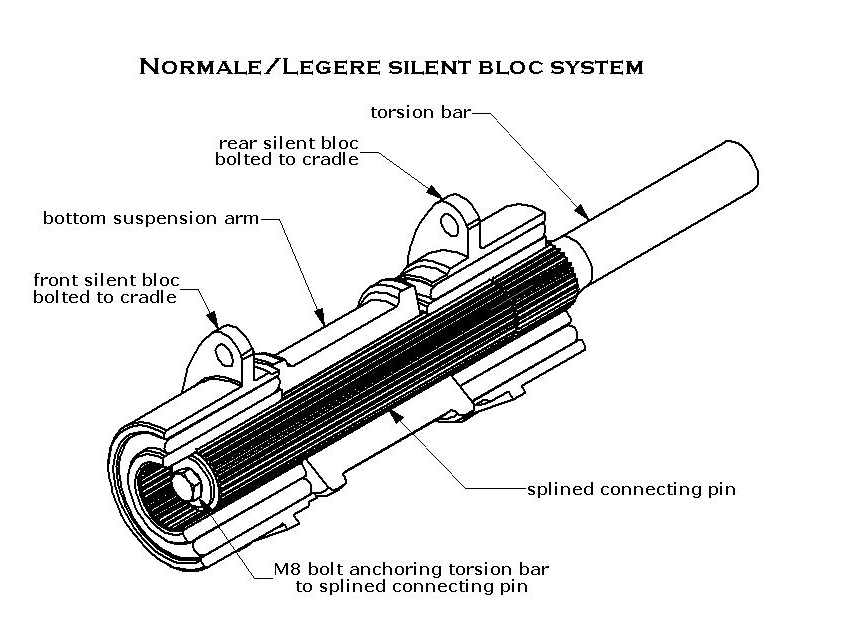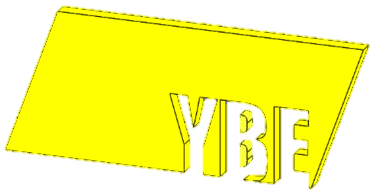Silent Block Upgrades 4 Cylinder Cars
In the rush to get the Traction built certain parts had serious engineering flaws that were not addressed during its 23 year production life.
The design of the silent bloc type suspension system is a prime example of this. Nowadays these sort of flaws would certainly not be tolerated, however in the forties and fifties it seemed everyone was just thankful to have a car.
In this article the cars referred to are the four cylinder Traction models i.e. the ‘Legere’, ‘Normale’, ‘Familiale’ and ‘Commerciale’. For ease of writing from this point onwards only the ‘Normale’ and ‘Legere’ will be mentioned and the focus will be entirely on the silent bloc system.
If you ever assemble a front cradle you will notice how loose the splined connecting pin is as it enters the rear silent bloc yet how difficult it is to get it into its final ‘installed’ position. This is a result of the tapered splined connecting pin. The looseness seen in the rear silent bloc during assembly is what it is like in the front silent bloc once fully assembled. This is a major design flaw with the original parts and results in the splines situated in the front silent bloc and their mating ones on the connecting pin wearing badly. As well as the splined connection having to be good the system also relies on the integrity of the rubber connecting the broached tube to the silent bloc housing.
The principle of the design for the ‘Normale’ and ‘Legere’ silent bloc system is that a splined pin connects the bottom suspension arm to the front and rear silent blocs that are bolted to the cradle. As shown in the picture above.
The original design had a tapered splined connecting pin. During installation the connecting pin was pressed in through the rear silent bloc, through the bottom suspension arm, and into the front silent bloc. The torsion bar was then fed into the rear silent bloc and anchored via a long bolt. When the splined connecting pin was installed it got progressively tighter as it passed through the suspension assembly. The assembly required a significant amount of force available only through a heavy press.
During the Traction's production life the design of the splined connecting pins remained unchanged except that in the later years the central 50mm was unsplined. I am guessing that this was an economy measure. However this reduced the engagement between the bottom suspension arm and the connecting pin by ≈60% and caused the broaching at the outer edges of the bottom suspension arm to 'bellmouth'.
Often the rubber is badly worn as would be expected after 50+ years of service. An example of this type of worn rubber is shown in the pictures above. As can be seen here the rubber has seen better days since the cars initial manufacture. Note how worn the splines are in the broached tube and the poor state of the rubber bonding. Remember that the whole suspension geometry relies on the silent bloc assembly being 'tight' and that all the forces created during braking and steering are transferred to the car body via the cradle, silent blocs, bottom suspension arm and the splined connecting pin.
When MOTs were mandatory it seemed that most MOT test stations did not know how to check the integrity of the silent bloc system and so took the approach that it was an old car, not driven very far or fast and that they would be alright.
Of all the routine jobs on a Traction I would say the replacement of the silent blocs is one of the most awkward. The engine/gearbox has to come out and the grille and front wings removed and the body has to be safely supported to enable the front cradle to be pulled off. This makes the car totally immoveable until the cradle has been replaced. Be under no illusion that any original silent bloc system, which will be 50+ years old, may appear to be in good condition on the outside but closer inspection will invariably find it to have failed. Rubber, even with anti ageing additives, has a finite life that is considerably less than 50 years.
When ‘rubbering’ it is impossible to bond the broached tube concentrically in the silent bloc housing and as a result extra stresses are incurred during assembly. The longitudinal position of the broached tube in the silent bloc housing can also vary and this is why the original system used packing shims to get the bottom arms in correct alignment and provide the correct 'nip' between the silent blocs and the bottom suspension arm. Because of the variation in the relative positions of the components in the silent bloc it can often happen that the cradle cannot be assembled to give the correct alignment/nip/etc by use of the available shims. The stripping or assembly of the original silent bloc system requires the careful use of a series of supporting plates/tubes and a powerful press or a lot of brute force with a sledgehammer. I think it unlikely that when the cradles were originally assembled, either in the factory or as a repair in a garage, that they were stripped down and reassembled if the shims gave the wrong alignment.
There are many repair jobs on a Traction where the cost of the replacement part is a small proportion of the total repair cost. The fitting and/or adjusting of a new part can be time consuming and hence expensive if you do not do it yourself and in a lot of cases it can be technically difficult often requiring specialist tools and a high level of expertise and experience. A fully machined part that just has to be fitted is usually much easier and, in many cases, can be a more economical option. This often holds true for silent blocs on Tractions.
‘Yellow Box Engineering Ltd’ supplies full silent bloc sets for both ‘Normale’ and ‘Legere’ cars. These silent bloc sets eliminate the problems that plagued the original parts during their operating lives. The newly manufactured silent bloc sets are high precision parts made from new materials using specially designed tools. They are made to order in small batches and have a 100% inspection rate for superior quality. The silent bloc sets are fully compatible with the Normale/Legere cradle and bottom suspension arms. This leads too many advantages such as:
- A heavy press not being required to fit them - it can be done by a single person with a 7lb (≈3kg) copper hammer, this significantly reduced the time and effort required for installation.
- They dispense with packing shims yet give the correct alignment and 'nip' to the bottom suspension arm thus making the suspension system work as the original design intended.
- They give full and even contact between the splined connecting pin, the broached tube in the silent bloc and bottom suspension arm, resulting in a more durable and properly performing suspension system.
- The splined tube is concentric with the housing and hence no additional stresses are induced during assembly, this results in a longer life for the silent bloc.
Note the silent bloc housings are machined from a solid billet of steel, the broached tube is concentric with the silent bloc housing and the connecting pin is splined over its full length.




